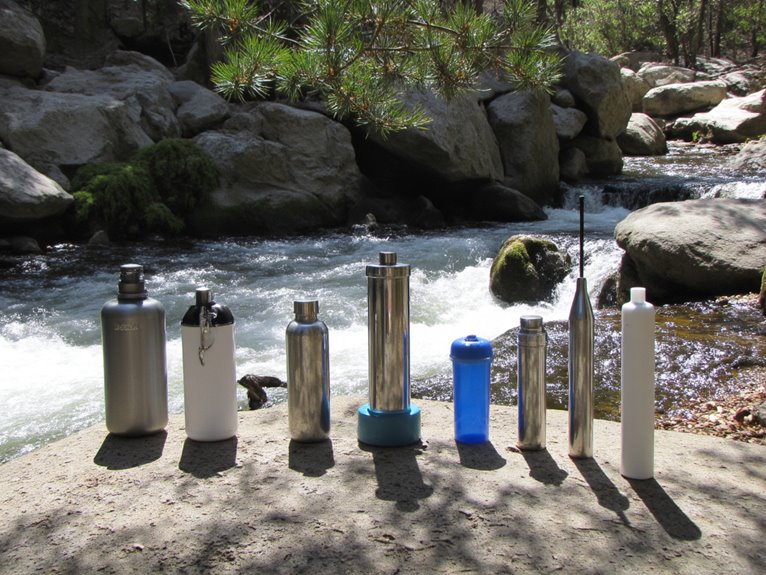Can River Water Be Purified?
River water can be effectively purified through a combination of physical, chemical, and biological processes. Physical barriers like mesh screen filters and ceramic element filters remove debris and suspended solids, while chemical treatments like coagulation and flocculation clarify water and remove impurities. Biological processes, such as biodegradation and bioaccumulation, decompose organic matter and remove pollutants. Advanced technologies like ozone treatment, UV light disinfection, and nanofiltration further improve purification. As the complexity of river water contamination unfolds, innovative solutions and collaborative efforts are necessary to safeguard the health and well-being of aquatic ecosystems and human populations. The journey to purification has just begun.
We are supported by our audience. When you purchase through links on our site, we may earn an affiliate commission, at no extra cost for you. Learn more. Last update on 21st December 2025 / Images from Amazon Product Advertising API.
Understanding River Water Contamination
River water contamination is a pervasive issue worldwide, with pollutants originating from human activities, natural sources, and climate change combining to jeopardize the health of aquatic ecosystems and human populations that rely on rivers for drinking water, recreation, and livelihoods.
The most common contaminants include industrial chemicals, agricultural runoff, sewage, and plastic waste.
These pollutants can have devastating effects on aquatic life, including altered species composition, reduced biodiversity, and increased disease prevalence.
In addition, human exposure to contaminated river water can lead to waterborne diseases, cancer, and other health problems.
Understanding the sources and impacts of river water contamination is essential for developing effective strategies to mitigate this pressing environmental issue.
Purification Methods for River Water
Effective purification methods are essential for removing pollutants and contaminants from river water, restoring its natural quality and ensuring the health and well-being of both aquatic ecosystems and human populations.
There are several purification methods that can be employed to achieve this goal. Chemical coagulation and sedimentation can remove suspended particles and contaminants, while filtration and disinfection can eliminate bacteria and viruses.
Advanced oxidation processes, such as ozone and UV treatment, can break down organic pollutants. Additionally, natural treatment systems, like wetlands and aquatic plants, can also be used to purify river water.
These methods can be used individually or in combination to effectively remove pollutants and contaminants, resulting in cleaner and safer water for human consumption and aquatic life.
Physical Barriers for Water Filtration
As we venture into the domain of physical barriers for water filtration, we find ourselves at the threshold of a trio of innovative solutions.
Mesh screen filters, ceramic element filters, and cartridge systems stand out as pioneering technologies, each boasting unique strengths in the pursuit of purer river water.
Mesh Screen Filters
In the pursuit of purifying river water, mesh screen filters have emerged as a reliable physical barrier for removing debris and suspended solids from the water stream.
These filters consist of a mesh screen with tiny openings that block larger particles, allowing only clean water to pass through.
The mesh material can be tailored to specific micron sizes, enabling effective removal of contaminants.
As water flows through the mesh, impurities are trapped, and the filtered water is collected on the other side.
Mesh screen filters are often used as a pre-treatment step, protecting downstream filtration systems from clogging and ensuring efficient operation.
Ceramic Element Filters
Ceramic element filters, a type of physical barrier for water filtration, utilize ceramic materials with microscopic pores to remove impurities from river water, providing a robust and durable solution for water treatment.
These filters are highly effective in removing particulate matter, bacteria, viruses, and parasites, making them an excellent choice for purifying river water.
The ceramic material's small pores block contaminants, allowing only clean water to pass through, resulting in a significant reduction in turbidity and improved water quality.
Ceramic element filters are also resistant to corrosion, easy to clean, and maintain, making them a reliable option for river water purification.
Cartridge Systems
Relying on replaceable cartridges, cartridge systems offer a convenient and efficient means of physically blocking contaminants from river water, thereby providing a consistent flow of purified water.
These systems utilize a series of filters with varying pore sizes to capture impurities, providing a thorough barrier against contaminants.
The cartridges are designed to be easily replaced, making maintenance a breeze.
This design guarantees that the system remains effective over time, without compromising on water quality.
With cartridge systems, river water purification becomes a streamlined process, yielding a reliable source of clean drinking water.
Chemical Treatment of River Water
As we venture into the domain of chemical treatment, we find ourselves at the threshold of a multifaceted process that transforms raw river water into a potable resource.
This journey begins with coagulation and flocculation, where chemical agents are carefully introduced to aggregate impurities, followed by the removal of these newly formed clusters.
Next, disinfection methods are employed to eradicate any remaining pathogens, ultimately yielding water that is safe for human consumption.
Coagulation and Flocculation
Chemical treatment of river water through coagulation and flocculation is a crucial step in the purification process, as it enables the removal of dirt and other suspended particles that can affect the water's quality and clarity.
This process involves the addition of chemicals that neutralize the electrical charges of particles, allowing them to stick together and form larger clumps, known as flocs. These flocs are then easily removed from the water, resulting in a clearer and cleaner liquid.
Improved water clarity: The removal of suspended particles results in clearer water.
Reduced turbidity: The process minimizes the amount of dirt and other contaminants in the water.
Enhanced filtration: Coagulation and flocculation prepare the water for further treatment, making it easier to remove impurities.
Increased water quality: The removal of suspended particles improves the overall quality of the water.
Removal of Impurities
Following coagulation and flocculation, the next essential step in purifying river water is the removal of impurities through targeted chemical treatment, which specifically targets dissolved contaminants and inorganic compounds.
This process involves the addition of chemicals that react with the impurities, converting them into insoluble precipitates that can be easily removed.
Activated carbon, for instance, is commonly used to absorb organic compounds, heavy metals, and other pollutants.
Other chemical treatments may include the addition of oxidizing agents to break down complex organic molecules or the use of ion exchange resins to remove dissolved ions.
Disinfection Methods
River water disinfection, a pivotal step in the purification process, involves the targeted elimination of microbial contaminants through the strategic application of disinfectants. This critical stage guarantees the removal of harmful pathogens, making the water safe for human consumption.
Several disinfection methods are employed, including:
- Chlorination: The most common method, which involves adding chlorine to the water to kill microorganisms.
- Ultraviolet (UV) light: Exposing water to UV light to inactivate microbial contaminants.
- Ozone treatment: Using ozone gas to oxidize and eliminate microorganisms.
- Filtration: Physical removal of microorganisms through membrane filters or other mechanisms.
These disinfection methods are essential in guaranteeing the water is free from microbial contaminants, making it safe for human consumption.
Biological Processes for Water Purification
In aquatic ecosystems, microorganisms play a crucial role in decomposing organic matter, thereby facilitating the natural purification of river water.
Biological processes, such as biodegradation and bioaccumulation, are essential for removing pollutants and contaminants from river water.
Microorganisms like bacteria, fungi, and algae break down organic pollutants, converting them into harmless compounds.
Additionally, aquatic plants and phytoplankton absorb excess nutrients, reducing the risk of eutrophication.
These natural processes can be improved through artificial wetlands, biofilters, and bioreactors, which provide a controlled environment for microorganisms to thrive.
By harnessing the power of biological processes, river water can be effectively purified, making it safe for human consumption and other uses.
This natural approach to water purification is both efficient and environmentally friendly.
Advanced Technologies for River Water
Advanced oxidation processes, such as ozone and hydrogen peroxide treatments, are being increasingly utilized to destroy complex organic pollutants and micropollutants in river water.
These cutting-edge technologies are transforming the way we purify river water, offering a more effective and efficient solution to traditional methods.
Some of the advanced technologies being employed include:
- Ultraviolet (UV) light disinfection: using UV light to kill bacteria and other microorganisms.
- Nanofiltration and reverse osmosis: using membranes with tiny pores to remove impurities and contaminants.
- Advanced chemical oxidation: using oxidizing agents to break down pollutants.
- Electrochemical treatment: using electric currents to oxidize pollutants and remove contaminants.
These advanced technologies are paving the way for cleaner, safer, and more sustainable river water purification.
Challenges in River Water Purification
Despite significant advances in purification technologies, numerous hurdles continue to hinder the quest for pristine river water.
One major challenge is the presence of emerging contaminants, such as pharmaceuticals and personal care products, which are not effectively removed by traditional treatment methods.
Additionally, climate change and extreme weather events can overwhelm treatment plants, leading to untreated wastewater discharge into rivers.
In addition, aging infrastructure and inadequate funding can impede the implementation of effective purification systems.
These challenges underscore the need for innovative solutions and collaborative efforts to address the complexities of river water purification.



